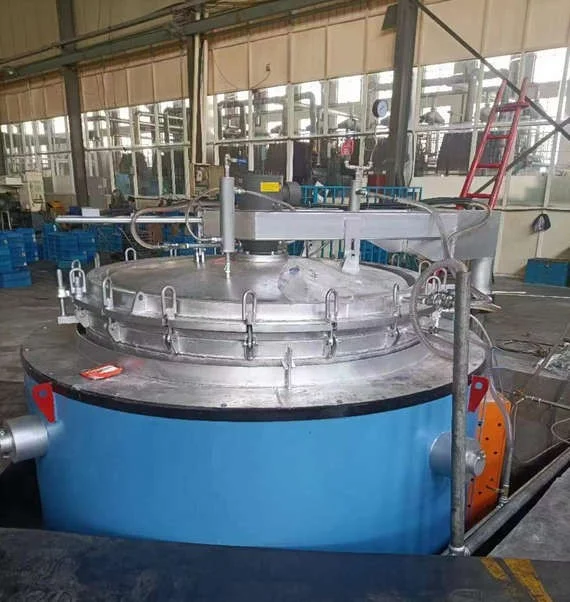- This topic is empty.
-
AuthorPosts
-
2025-08-21 at 5:03 pm #7357
In industrial heat treatment, the nitrogen protected annealing furnace has become a critical piece of equipment. Unlike traditional furnaces that operate in air and risk oxidation of the workpiece, this system maintains a stable nitrogen atmosphere, protecting metals and alloys during thermal processing. The result is not just improved surface quality but also a controlled microstructure that directly affects product performance. In this blog post, Yifam will share the role of nitrogen protected annealing furnace in heat treatment, its technical principles, industrial applications, etc.
Why Use Nitrogen in Annealing Furnaces?
The choice of nitrogen is not accidental. As an inert gas, nitrogen provides a cost-effective and readily available protective atmosphere. Inside a nitrogen annealing furnace, the gas displaces oxygen, minimizing scaling, discoloration, and unwanted chemical reactions. This makes it especially suitable for industries where surface integrity and material purity are vital, such as stainless steel strip production, precision automotive parts, and electrical components.
Moreover, compared with argon or helium, nitrogen strikes the balance between affordability and efficiency. Its wide industrial accessibility makes it the standard for protected annealing furnace operations.
Technical Principles of Nitrogen Protected Annealing
The functionality of a nitrogen protected annealing furnace relies on a closed chamber where nitrogen is introduced to create a low-oxygen environment. Sensors continuously monitor gas concentration, temperature, and flow, ensuring that the protective atmosphere remains stable.
The annealing cycle typically involves three steps:
-
Heating Phase – Workpieces are gradually heated to the recrystallization temperature, often between 600–900°C depending on the alloy.
-
Soaking Phase – The furnace maintains this temperature for a controlled duration, allowing grain structure refinement.
-
Cooling Phase – Rapid or controlled cooling under nitrogen prevents oxidation and ensures uniform metallurgical properties.
Through this process, metals gain improved ductility, stress relief, and enhanced machinability without surface degradation.
Industrial Applications of Nitrogen Atmosphere Furnaces
The nitrogen protected annealing furnace plays a vital role across multiple sectors:
-
Automotive Industry: Gears, shafts, and springs are heat-treated to achieve fatigue resistance and dimensional stability.
-
Metallurgical Industry: Stainless steel coils and wires undergo nitrogen annealing to prevent surface defects and achieve mirror-like finishes.
-
Electronics Manufacturing: Copper and aluminum conductors are annealed in nitrogen to improve conductivity while avoiding oxidation.
-
Toolmaking: High-carbon steels treated in nitrogen atmospheres retain precision without losing hardness or surface quality.
This versatility highlights the furnace’s adaptability to both large-scale industrial production and specialized high-precision applications.

Environmental Considerations of Nitrogen Protected Annealing
In modern industry, sustainability is no longer optional. The nitrogen protected annealing furnace contributes to greener production in several ways:
-
Reduced Waste: By preventing oxidation and scaling, less post-processing like pickling or surface grinding is required.
-
Lower Emissions: Since nitrogen is abundant in the atmosphere, its production has a relatively low carbon footprint compared to noble gases.
-
Resource Efficiency: Extending tool life and reducing scrap directly supports sustainable manufacturing.
This aligns with global initiatives where industrial furnaces must balance efficiency with environmental responsibility.
Comparing Nitrogen Furnaces with Other Annealing Methods
To fully understand the significance of the nitrogen protected annealing furnace, it helps to compare it with alternatives:
-
Air Furnaces: Inexpensive but prone to oxidation, making them unsuitable for high-quality surface applications.
-
Vacuum Annealing Furnaces: Provide an even cleaner environment than nitrogen but at a significantly higher cost.
-
Argon Furnaces: Highly effective but economically prohibitive for large-scale operations.
From this perspective, the nitrogen system represents a middle ground solution—offering strong protection at manageable costs, making it the most practical choice for mainstream industrial use.
Challenges in Nitrogen Protected Annealing Furnace Operation
Despite its many benefits, operating a nitrogen protected annealing furnace is not without challenges:
-
Gas Purity Management: Contamination of nitrogen with trace oxygen can lead to inconsistent results.
-
Energy Consumption: Maintaining high-temperature stability requires significant energy input.
-
Maintenance of Seals and Valves: Any leakage compromises the protective atmosphere.
-
Integration with Automation: Advanced industries require real-time monitoring and digital control, which demands investment in smart furnace systems.
Addressing these challenges is essential for industries aiming for consistent and reliable results.
Innovations in Nitrogen Furnace Technology
Recent years have seen innovations transforming the protected annealing furnace with nitrogen atmosphere into a smarter and more energy-efficient tool:
-
IoT Integration: Real-time monitoring of gas flow, temperature, and furnace performance.
-
Hybrid Atmospheres: Combining nitrogen with small percentages of hydrogen to enhance surface brightness in stainless steel treatment.
-
Energy Recovery Systems: Capturing and reusing waste heat to lower operational costs.
-
AI-Based Process Control: Using predictive algorithms to optimize annealing cycles, reduce defects, and save energy.
These trends suggest that the nitrogen furnace will remain central to heat treatment while becoming increasingly advanced.
Conclusion
The nitrogen protected annealing furnace is far more than a piece of industrial equipment—it is a symbol of how manufacturing adapts to balance quality, efficiency, and sustainability. By creating a controlled protective atmosphere, it safeguards the integrity of metals while supporting high-performance applications in automotive, electronics, metallurgy, and beyond.
As innovations continue, this furnace type will not only remain relevant but also set new benchmarks in modern heat treatment technology.
http://www.yifam.com
Yifam -
-
AuthorPosts
- You must be logged in to reply to this topic.
